Dubai, 2012 – Since the blog post on my conquering my fear of working with polymer clay, I have created various polymer clay pendants and cufflinks. I enjoyed finding a cheaper solution to using precious metal clay especially when trying out new ideas. Finally I had overcome my fear of toxic fumes emanated from overbaked polymer clay (the instructions did scare me a bit).
But one thing that I have detested was making my own polymer clay canes using the millefiori technique. In fact, I never tried it. It was just too complicated for me and I don’t have time for complicated things. I prefer the simpler things in life like wire crochet jewelry, digital content strategy and creative direction.
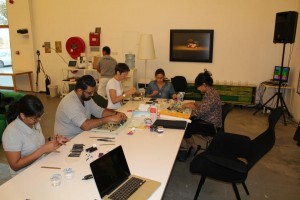
At the Workshop: Katarina sits opposite me. Adnan is a luxury watch maker. The lady on my right is an aspiring jewelry designer (Photo by Katarina)
Once I had overcome my fear about inhaling toxic fumes working with epoxy resin and baking polymer clay, I was presented with a great opportunity to face my ‘resistance’ against canes in the form of workshop by polymer clay professional Katarina Kovacev at Traffic Art Gallery. The other workshop participants were interested in knowing more about the craft itself, but I was there to wrestle the ‘whys’ behind my resistance towards making cane polymer clay.
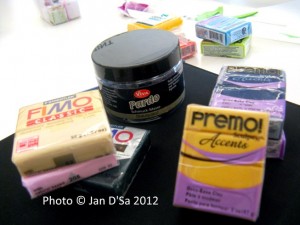
Different brands of Polymer clay. Translucent, shiny, matte.
As I rolled the clay into canes, plied with it to obey the shape of a beautiful butterfly, I found myself enjoying the process and the creative camaraderie of the participants. The photo below shows me rolling away what looks like cigarettes, but I assure you that this is the way to make polymer clay canes.
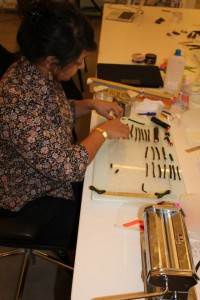
That’s me rolling the black and white canes. On my right is the pasta machine. On the left is a bottle of alcohol (to clean the pasta machine off clay bits caught in its engines of course!). Photo by Katarina.
Here is a snapshot as to the process of making my very own butterfly polymer clay cane.

Katarina already rolled the various clay colours for each of the students. I chose the orange and yellow colour sheet.
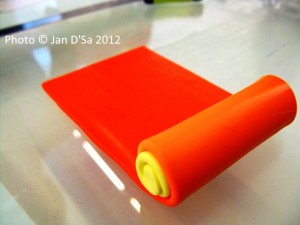
Roll the sheet upon itself.
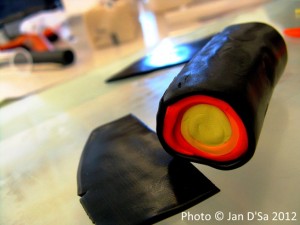
Cover it with one layer of black.
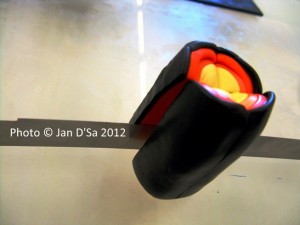
Splice time – Cut the cane into four equal pieces
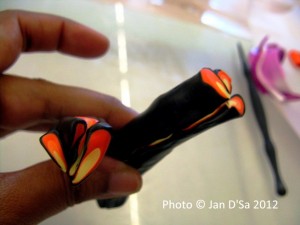
Pinch them so that they look like tear drops
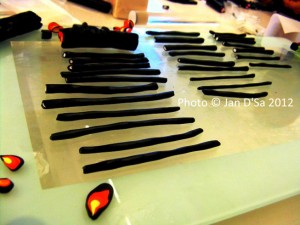
Time to make the white and black canes. We need them of different sizes so we roll them into big and small canes
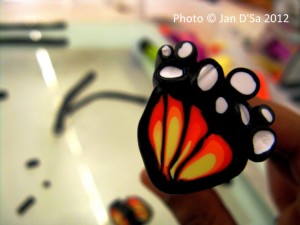
The idea is to stick the canes on top of the butterfly wings as shown.
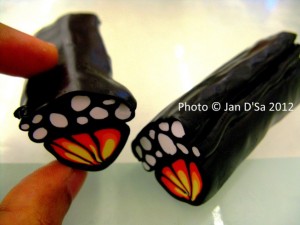
This is how they look like on the cane. Put a layer of black on top of the ‘bubbles.’
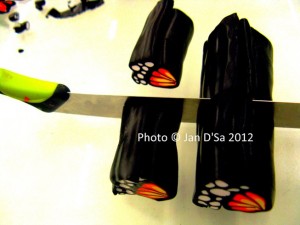
More splicing. That’s how the cane technique is. Splice, roll, pinch.
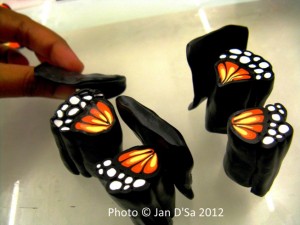
Building the body and the antennae. This was the tricky part for me but I managed to do it with Katarina’s help.
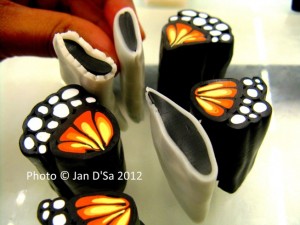
Cover the black body and antenna with translucent white as we need to see it as ‘space’ around the butterfly.
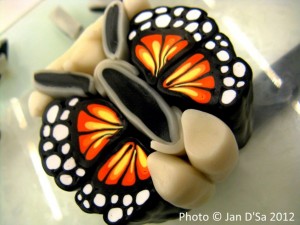
Empty space in the canes is not allowed. We had to fill spaces with the translucent clay.
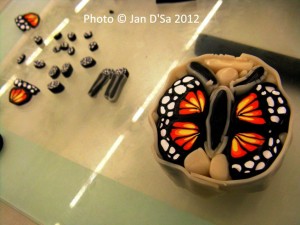
The last layer for this cane. Translucent white clay wrapped around the polymer clay cane. When this is done, it ends up being quite huge (as big as the palm of my hand).
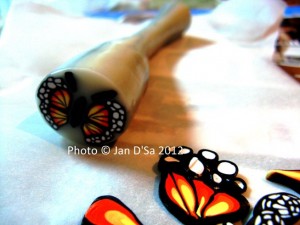
But now you start to roll as shown above. So that you get butterflies of different sizes. Big sizes for keychains. Smaller butterflies for earrings and pendants.
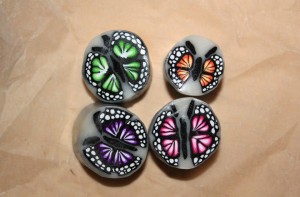
Photo by Katarina: Here are the different pretty butterflies done by the students.
At the end of three hours I gained a new appreciation of canes, thanks to the great instruction by Katarina. Her deft fingers rolling the clay, her passion in making clay talk is amazing and inspiring. Visit MojePerle to get more insight as to her beautiful works of art.
One word of advice from a cane novice. You just need a lot of patience, some amount of technical understanding to create the canes. I came away falling in love with clay all over again. And overcoming one more fear, one more challenge, so that I can feel liberated to live a better handcrafted life.
And here questions of type such if honestly strike me not much as I wrote everything higher. It is visible you simply you don’t want to read all this. As my parrot does.

where can i find polymer clay extruder in dubai?
Hi. Please write directly to MojePerle whose details are in this article. She will definitely know the answer. Thanks. Jan
Hi, I’m interested in polymer clay classes. Can you guide me on which way to proceed? Please provide me details of where these classes are conducted…
Dear Flo. I am sorry but MojePerle, who is featured in this blog post, no longer gives lessons in polymer clay in Dubai. You can check Dubai Arts Centre to see if they give lessons in clay.